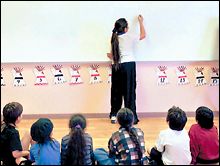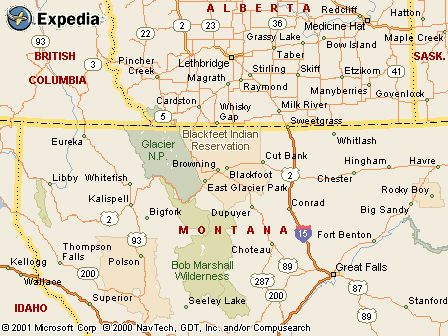|
|
Canku Ota |
|
|
(Many Paths) |
||
|
An Online Newsletter Celebrating Native America |
||
|
June 15, 2002 - Issue 63 |
||
|
|
||
|
Tribal Immersion Schools Rescue Language and Culture |
||
|
by Michelle Nijhuis | Special
to The Christian Science Monitor
|
||
|
credits:Tim Thompson
The Missoulian
|
|
He and a small group of Blackfeet friends longed to go home again, to reconnect with their culture and relearn the language they'd spoken as children. They were dismayed to find out that while they'd been away, the number of fluent speakers of Piegan, the Blackfeet language, had plummeted, and the remaining speakers were all more than 60 years old. So Mr. Kipp and his friends founded the Piegan Institute, a nonprofit organization dedicated to restoring and preserving native American languages. In 1995, the institute opened the privately funded Nizipuhwahsin(or Real Speak)Center, which immerses students in the Blackfeet language from kindergarten through eighth grade. The school's graduates are the first young fluent speakers of the Blackfeet language in a generation. Nizipuhwahsin teacher Shirlee Crow Shoe says the school is not only resuscitating the language, but also helping to preserve Blackfeet culture. "If you go into Indian country and ask a child 'Who's Indian?' most of the time they'll say 'Oh, it's those people who dance,' " she says. Her students, by contrast, "will put their hands out and introduce themselves to you in Blackfeet. Learning the language has clarified their identity." Overcoming
shame Many tribe members grew up ashamed of their native tongue. From the late 19th century until the 1970s, the federal Bureau of Indian Affairs forced thousands of students to attend schools far from reservations. Students were punished for speaking their languages, and many returned home with only vague memories of once-familiar words. Tribes started to regain control of their children's schooling in the late 1960s, and a few established language classes at high schools. But these fledgling efforts didn't produce fluent speakers, the lifeline of any language. Immersion
models Students are exposed to Maori or Hawaiian all day, every day, and study English only as a second language. The immersion-school model reached the mainland United States in 1985, when the Akwesasne Freedom School in upstate New York started creating fluent speakers of the Mohawk language. Impressed by the success of these schools, Kipp and the rest of the staff at the Piegan Institute thought immersion could bring back the Blackfeet language. To overcome resistance on the reservation, they showed a video of tribal elders speaking about their experiences with the language. "People realized we did not quit using the language out of choice," Kipp says. "Our parents and grandparents were forced to. They didn't pass the language down because they loved us, and they didn't want us to suffer the same abuse." Such campaigns are slowly restoring pride in tribal languages and the unique cultures they describe, says Mark Trahant, a journalist and a member of the Shoshone-Bannock tribe. "Now, there's a recognition that people are better off being multilingual. These languages contain a way of looking at the world that has a 10,000 year-old history.... Those of us who don't speak our language are viewed as less prepared for the world." Immersion schools are not for every tribe, says Inee Yang Slaughter of the Indigenous Language Institute in Santa Fe, N.M. "Immersion is the ideal situation for any language, but you have to look at the community." Fundraising responsibilities, complex tribal politics, and a shortage of qualified language teachers can easily turn an immersion school into an overwhelming project. Yet the idea is increasingly popular. Tribes have recently opened immersion schools in Nevada and Wisconsin. In one week in late April, the Nizipuhwahsin Center hosted visitors from the Kootenai tribe of Montana, the White Earth Band of the Ojibwe tribe of Minnesota, and the Tlingit tribe of Alaska. The Lannan Foundation, which has underwritten language-preservation projects throughout the US, estimates there are 50 tribes interested in starting immersion schools. The
power of language Dr. Hermes says there's another motivating force at work: the power of hearing a language, and a culture, come back to life. When her 6-year-old daughter said a prayer in Ojibwe at a recent powwow, she says, "there must have been 500 people in the audience, and they were blown away when they heard that.... They just yelled and yelled when she finished. On an emotional and spiritual level, what we're all doing is healing."
|
|
|
||
|
|
||
| Canku Ota is a free Newsletter celebrating Native America, its traditions and accomplishments . We do not provide subscriber or visitor names to anyone. Some articles presented in Canku Ota may contain copyright material. We have received appropriate permissions for republishing any articles. Material appearing here is distributed without profit or monetary gain to those who have expressed an interest. This is in accordance with Title 17 U.S.C. section 107. | ||
|
Canku Ota is a copyright © 2000, 2001, 2002 of Vicki Lockard and Paul Barry. |
||
|
|
|
|
|
The "Canku Ota - A Newsletter Celebrating Native America" web site and its design is the |
||
|
Copyright © 1999, 2000, 2001, 2002 of Paul C. Barry. |
||
|
All Rights Reserved. |
||

 Twenty
years ago, Darrell Kipp moved back to the Blackfeet Indian Reservation
in northwestern Montana. He'd been away from his birthplace long enough
to serve a tour of duty in Vietnam, earn two master's degrees, and establish
a career as a technical writer.
Twenty
years ago, Darrell Kipp moved back to the Blackfeet Indian Reservation
in northwestern Montana. He'd been away from his birthplace long enough
to serve a tour of duty in Vietnam, earn two master's degrees, and establish
a career as a technical writer. 